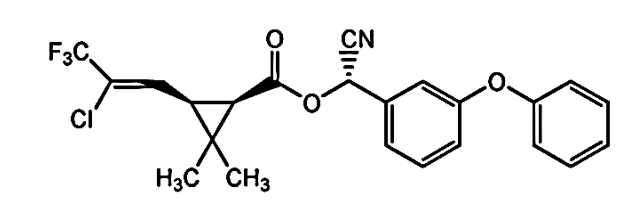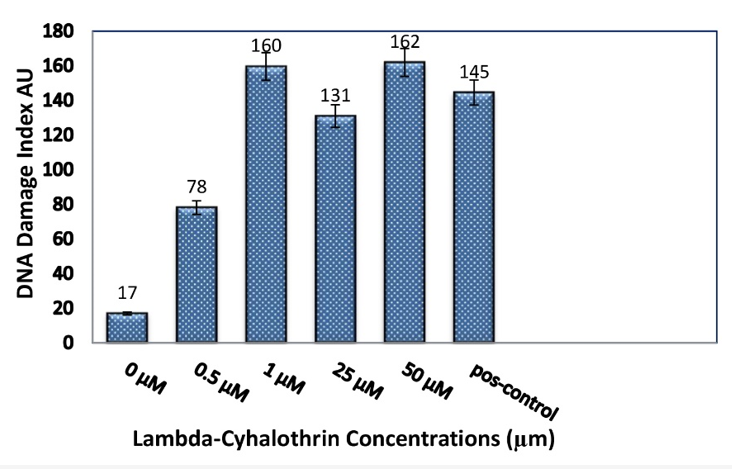1. Bajpayee M, Pandey AK, Parmar D, Dhawan A. Current status of short-term tests for evaluation of genotoxicity, mutagenicity, and carcinogenicity of environmental chemicals and NCEs. Toxicol Mech Methods. 2005;1;15(3):155-80. [
doi:10.1080/15376520590945667]
2. Nagy K, Rácz G, Matsumoto T, Ádány R, Ádám B. Evaluation of the genotoxicity of the pyrethroid insecticide phenothrin. Mutat Res Genet Toxicol Environ Mutagen. 2014 ;1;770:1-5. [
doi:10.1016/j.mrgentox.2014.05.001]
3. Mostafalou S, Abdollahi M. Pesticides and human chronic diseases: evidences, mechanisms, and perspectives. Toxicol Appl Pharmacol. 2013;268(2):157-77. [
doi:10.1016/j.taap.2013.01.025] [
pmid: 23402800]
4. Abdelmigid HM. New trends in genotoxicity testing of herbal medicinal plants. New insights into toxicity and drug testing. InTech. 2013:89-120. [
doi.org/10.5772/54858]
5. Mohanty G, Mohanty J, Dipta S, Dutt SK. Genotoxicity Testing in Pesticide Safety Evaluation. Pesticides in the Modern World - Pests Control and Pesticides Exposure and Toxicity Assessment. InTech. 2011. [
doi:10.5772/18726]
6. Soloneski S, L. M. Genetic Toxicological Profile of Carbofuran and Pirimicarb Carbamic Insecticides . Insecticides - Pest Engineering. In Tech; 2012. [
doi:10.5772/30137]
7. Zhang Q, Wang C, Sun L, Li L, Zhao M. Cytotoxicity of lambda-cyhalothrin on the macrophage cell line RAW 264.7. J Environ Sci (China). 2010; 1;22(3):428-32. [
doi:10.1016/S1001-0742(09)60125-X] [
pmid: 20614786]
8. Ibrahim HM. Evaluation of the immunotoxic effects of sub-chronic doses of lambda-cyhalothrin in murine model. MOJ. Immunol. 2016;3(6):1-8. [
doi:10.15406/moji.2016.03.00108]
9. Aziz KB and Abdel Rahem HM. Lambda, the pyrethroid insecticide as a mutagenic agent in both somatic and germ cells. J Am Sci. 2010;6:317-26. [
Link]
10. Chakravarthi K, Naravaneni R, and Philip GH. Study of cypermethrin cytogenesis effects on human lymphocytes using in-vitro techniques. J Appl Sci Environ Manage. 2007;11(2):77-81. [
doi:10.4314/jasem.v11i2.54994]
11. U.S. EPA. U.S. Environmental Protection Agency.2012. Office of Pesticide Programs: Chemicals Evaluated for Carcinogenic Potential. Annual Cancer Report: 1-29. [
Link]
12. Liu W, Gan J, Schlenk D, Jury WA. Enantioselectivity in environmental safety of current chiral insecticides. The PNAS. 2005;18;102(3):701-06. [
doi:10.1073/pnas.0408847102] [
pmid: 15632216]
13. Muranli FD. Genotoxic and cytotoxic evaluation of pyrethroid insecticides λ-cyhalothrin and α-cypermethrin on human blood lymphocyte culture. Bull Environ ContamToxicol. 2013;90:357-363. [
doi:10.1007/s00128-012-0909-z] [
pmid: 23229297]
14. Inyang IR, Obidiozo OZ, Izah SC. Effects of Lambda cyhalothrin in protein and Albumin content in the kidney and liver of Parpohiocephalus obscurus. EC PharmacolToxicol. 2016;2(3):148-53. [
Link]
15. Kim CW, Go RE, Choi KC. Treatment of BG-1 ovarian cancer cells expressing estrogen receptors with lambda-cyhalothrin and cypermethrin caused a partial estrogenicity via an estrogen receptor-dependent pathway. Toxicol Res. 2015;31(4):331-7. [
doi:10.5487/TR.2015.31.4.331]
16. Fetoui H, Feki A, Salah GB, Kamoun H, Fakhfakh F, Gdoura R. Exposure to lambda-cyhalothrin, a synthetic pyrethroid, increases reactive oxygen species production and induces genotoxicity in rat peripheral blood. Toxicol Ind Health.2015;31(5):433-41. [
doi:10.1177/0748233716635003] [
pmid: 23406951]
17. Çelik A, Mazmanci B, Çamlica Y, Çömelekoğlu Ü, Aşkin A. Evaluation of cytogenetic effects of lambda-cyhalothrin on Wistar rat bone marrow by gavage administration. Ecotoxicol Environ Sa. 2005a ;1;61(1):128-33. [
doi:10.1016/j.ecoenv.2004.07.009]
18. Çelik A, Mazmanci B, Camlica Y, Aşkin A, Çömelekoğlu Ü. Induction of micronuclei by lambda-cyhalothrin in Wistar rat bone marrow and gut epithelial cells. Mutagenesis. 2005b;1;20(2):125-29. [
doi:10.1093/mutage/gei020]
19. Muranli FD, Güner U. Induction of micronuclei and nuclear abnormalities in erythrocytes of mosquito fish (Gambusia affinis) following exposure to the pyrethroid insecticide lambda-cyhalothrin. Mutat Res. 2011; 24;726(2):104-8. [
doi:10.1016/j.mrgentox.2011.05.004] [
pmid: 21620996]
20. Georgieva SV. Investigation of the cytogenetic effect of the insecticide karate on rabbit peripheral blood lymphocytes. Trakia J Sci. 2006;4(2):34-38. [
Link]
21. Velmurugan B, Ambrose T, Selvanayagam M. Genotoxic evaluation of lambda-cyhalothrin in Mystusgulio. J Environ Biol. 2006;27(2):247-50. [Link] [
Link]
22. Saleh M, Ezz-din D, Al-Masri A. In vitro genotoxicity study of the lambda-cyhalothrin insecticide on Sf9 insect cells line using Comet assay.JJBS. 2021;1;14(2): 213-17. [
doi:10.54319/jjbs/140203]
23. Deeba F, Raza I, Muhammad N, Rahman H, ur Rehman Z, Azizullah A, Khattak B, Ullah F, Daud MK. Chlorpyrifos and lambda cyhalothrin-induced oxidative stress in human erythrocytes: in vitro studies. Toxicol Health. 2017; 33(4):297-307. [
doi:10.1177/0748233716635003] [
pmid: 27102427]
24. Davila JC, Cezar GG, Thiede M, Strom S, Miki T, Trosko J. Use and application of stem cells in toxicology. Toxicol Sci. 2004;1;79(2):214-23. [
doi:10.1093/toxsci/kfh100]
25. Chalisserry EP, Nam SY, Park SH, Anil S. Therapeutic potential of dental stem cells. J Tissue Eng. 2017;20;8:1-17. [
doi:10.1177/2041731417702531]
26. Hatab TA, Kochaji N, Issa N, Nadra R, Saleh M, Rahmo A, Rekab M. In vivo and immunohisto-chemical study of dentin and pulp tissue regeneration in the root canal. J Chem Pharm Res. 2015;7(5):302-10. [
Link]
27. Borenfreund E, Babich H, Martin-Alguacil N. Comparisons of two in vitro cytotoxicity assays - the neutral red (NR) and tetrazolium MTT tests. Toxicol In Vitro.1988;2(1):1-6. [
doi:10.1016/0887-2333(88)90030-6] [
pmid: 20702351]
28. Liu JW, Cai MX, Xin Y, Wu QS, Ma J, Yang P, Xie HY, Huang DS. Parthenolide induces proliferation inhibition and apoptosis of pancreatic cancer cells in vitro.J Exp Clin Cancer Res. 2010; 29(1):1-7. [
doi:10.1186/1756-9966-29-108] [
pmid: 20698986]
29. Collins AR. The comet assay for DNA damage and repair: principles, applications, and limitations. Mol Biotechnol.2004;26(3):249-61. [doi:10.1385/MB:26:3:249] [
doi:10.1385/MB:26:3:249]
30. García O, Romero I, González JE, Moreno DL, Cuétara E, Rivero Y, Gutiérrez A, Pérez CL, Álvarez A, Carnesolta D, Guevara I. Visual estimation of the percentage of DNA in the tail in the comet assay: Evaluation of different approaches in an intercomparison exercise. Mutation Research/Genetic Toxicology and Environmental Mutagenesis. 2011;720(1-2):14-21. [
doi:10.1016/j.mrgentox.2010.11.011]
31. Kakko I, Toimela T, Tähti H. Oestradiol potentiates the effects of certain pyrethroid compounds in the MCF7 human breast carcinoma cell line. ATLA. 2004;32(4):383-90. [doi:10.1289/ehp.99107173] [
doi:10.1289/ehp.99107173]
32. Tukhtaev K, Tulemetov S, Zokirova N, Tukhtaev N. Effect of long term exposure of low doses of lambda-cyhalothrin on the level of lipid peroxidation and antioxidant enzymes of the pregnant rats and their offspring. J Res Health Sci. 2012;13:93-9. [
doi:10.15208/mhsj.2012.67]
33. Naravaneni R, Jamil K. Evaluation of cytogenetic effects of lambda‐cyhalothrin on human lymphocytes. J Biochem Mol Toxic. 2005;19(5):304-10. [
doi:10.1002/jbt.20095] [
pmid:16292750]
34. Wang Q, Xia X, Deng X, Li N, Wu D, Zhang L, et al. Lambda-cyhalothrin disrupts the up-regulation effect of 17β-estradiol on post-synaptic density 95 protein expression via estrogen receptor α-dependent Akt pathway. J Environ Sci. 2016; 1;41:252-60. [
doi:10.1016/j.jes.2015.04.037] [
pmid: 26969072]
35. Zhao M, Zhang Y, Liu W, Xu C, Wang L, Gan J. Estrogenic activity of lambda‐cyhalothrin in the MCF‐7 human breast carcinoma cell line. Environ Toxicol Chem.2008;27(5):1194-200. [
doi:10.1897/07-482.1] [
pmid: 18419197]
36. Du G, Shen O, Sun H, Fei J, Lu C, Song L, Xia Y, Wang S, Wang X. Assessing hormone receptor activities of pyrethroid insecticides and their metabolites in reporter gene assays. Toxicol Sci. 2010;116(1):58-66. [
doi:10.1093/toxsci/kfq120] [
pmid: 20410157]
37. Brander SM, Gabler MK, Fowler NL, Connon RE, Schlenk D. Pyrethroid pesticides as endocrine disruptors: molecular mechanisms in vertebrates with a focus on fishes. Environ Sci Technol.2016;50(17):8977-92. [
doi:10.1021/acs.est.6b02253]
38. Wang Y, Yan M, Yu Y, Wu J, Yu J, Fan Z. Estrogen deficiency inhibits the odonto/osteogenic differentiation of dental pulp stem cells via activation of the NF-κB pathway. Cell Tissue Res. 2013;352(3):551-59. [
doi:10.1091/mbc.e09-01-0085]
39. Ling-Ling E, Xu WH, Liu Y, Cai DQ, Wen Nand Zheng WJ, Estrogen enhances the bone regeneration potential of periodontal ligament stem cells derived from osteoporotic rats and seeded on nano-hydroxyapatite/collagen/poly (L-lactide). Int J Mol Med. 2016;37(6):1475-86. [
doi:10.3892/ijmm.2016.2559] [
pmid: 27082697]
40. Hong L, Zhang G, Sultana H, Yu Y, Wei Z. The effects of 17-β estradiol on enhancing proliferation of human bone marrow mesenchymal stromal cells in vitro. Stem cells Dev. 2011;20(5):925-31. [
doi:10.1089/scd.2010.0125] [
pmid: 20735179]
41. Bustamante-Barrientos FA, Méndez-Ruette M, Ortloff A, Luz-Crawford P, Rivera FJ, Figueroa CD, et al. The impact of estrogen and estrogen-like molecules in neurogenesis and neurodegeneration: beneficial or harmful? Front Cell Neurosci.2021;15:636176. [
doi:10.3389/fncel.2021.636176] [
pmid: 33762910]
42. Froushani SM. The effect of mesenchymal stem cells pulsed with 17 beta-estradiol in an ameliorating rat model of ulcerative colitis. Zahedan J Res Med Sci.2019; 31;21(4). [
doi:10.1159/000445583]
43. Kuechler EC, de Lara RM, Omori MA, Schroeder A, Teodoro VB, Baratto-Filho F, et al. Estrogen deficiency affects tooth formation and gene expression in the odontogenic region of female rats. Ann Anat. 2021;236:151702. [
doi:10.1016/j.aanat.2021.151702] [
pmid:33607226]
44. Pedram A, Razandi M, Evinger AJ, Lee E, Levin ER. Estrogen inhibits ATR signaling to cell cycle checkpoints and DNA repair. Mol Biol cell. 2009;15;20(14):3374-89. [
doi:10.1091/mbc.e09-01-0085] [
pmid: 19477925]
45. Remington SE. Cellular response to DNA damage after exposure to organophosphates in vitro (Doctoral dissertation, Newcastle University). 2010. [
Link]
46. Jiménez-Salazar JE, Damian-Ferrara R, Arteaga M, Batina N, Damián-Matsumura P. Non-Genomic actions of estrogens on the DNA repair pathways are associated with chemotherapy resistance in breast cancer. Front Oncol 2021;11:631007. [
doi:10.3389/fonc.2021.631007]
47. Caldon CE. Estrogen signaling and the DNA damage response in hormone dependent breast cancers. Front Oncol. 2014;14;4:106. [
doi:10.3389/fonc.2014.00106] [
pmid: 24860786]














































